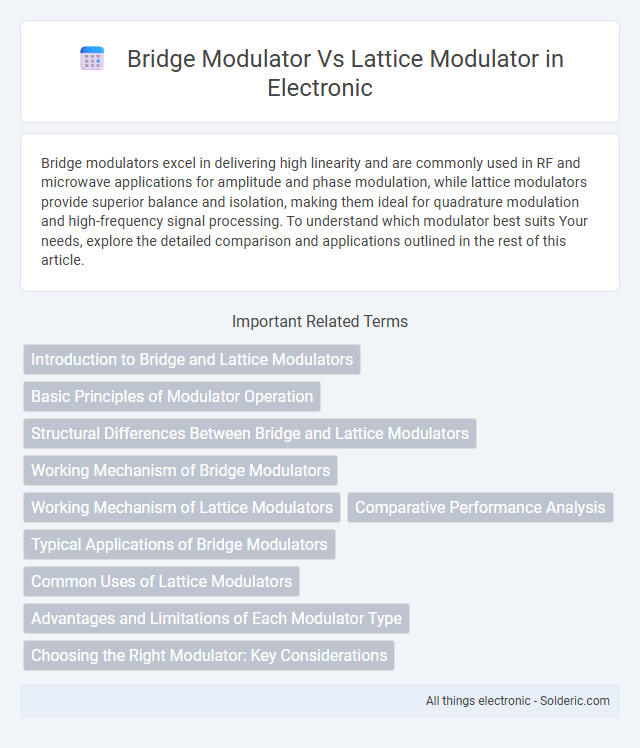Bridge modulators excel in delivering high linearity and are commonly used in RF and microwave applications for amplitude and phase modulation, while lattice modulators provide superior balance and isolation, making them ideal for quadrature modulation and high-frequency signal processing. To understand which modulator best suits Your needs, explore the detailed comparison and applications outlined in the rest of this article.
Comparison Table
| Feature | Bridge Modulator | Lattice Modulator |
|---|---|---|
| Circuit Topology | Bridge configuration with four elements forming a loop | Lattice structure with two arms crossing each other |
| Impedance Matching | Typically requires external matching network | Intrinsic good impedance matching properties |
| Modulation Type | Amplitude modulation (AM) and Double Sideband Suppressed Carrier (DSB-SC) | Often used for phase and amplitude modulation |
| Carrier Suppression | High carrier suppression achievable | Excellent carrier suppression due to balanced topology |
| Complexity | Simple, fewer components | More complex, requires precise balance |
| Applications | Standard AM transmitters, modulators in RF systems | Phased arrays, balanced modulators, advanced RF systems |
Introduction to Bridge and Lattice Modulators
Bridge modulators and lattice modulators serve as key components in RF and microwave signal processing, each offering distinct structural advantages. The bridge modulator features a configuration based on a bridge circuit, providing precise amplitude and phase control, making it ideal for balanced signal modulation. Lattice modulators employ a network of interconnected reactive elements forming a lattice structure that excels in achieving high isolation and linearity, enhancing the quality of Your modulation applications.
Basic Principles of Modulator Operation
Bridge modulators operate by combining two balanced mixers in a bridge configuration to modulate the amplitude or phase of a signal with high linearity and low distortion. Lattice modulators use a network of beam splitters and phase shifters to achieve precise control over modulation depth and phase, often resulting in enhanced signal purity. Your choice depends on the required modulation accuracy and complexity of the application.
Structural Differences Between Bridge and Lattice Modulators
Bridge modulators feature a symmetrical transistor arrangement forming a bridge circuit that enables balanced signal modulation by alternating current paths, whereas lattice modulators employ a crisscross network of reactive components creating a lattice structure that offers precise control over phase and amplitude. Structural differences impact linearity and efficiency, with bridge modulators typically providing robust balance and reduced distortion while lattice modulators excel in complex impedance matching and signal purity. Understanding these distinctions helps optimize your choice based on modulation requirements and circuit complexity.
Working Mechanism of Bridge Modulators
Bridge modulators operate by utilizing a balanced bridge circuit, typically consisting of four diodes or transistors arranged in a ring configuration, which invert the polarity of the carrier signal in response to the modulating signal. This configuration enables the suppression of the carrier frequency while generating double sideband suppressed carrier (DSB-SC) signals, crucial for efficient amplitude modulation. The modulation depth and linearity depend on the precise control of diode conduction angles or transistor switching within the bridge network.
Working Mechanism of Lattice Modulators
Lattice modulators operate by controlling the interference of two signal branches, adjusting their amplitudes and phases to achieve the desired modulation with high linearity and low distortion. This mechanism relies on the precise combination of input signals processed through a lattice network, which splits and recombines the signals to generate the output. Your communication system benefits from lattice modulators' ability to minimize signal degradation compared to bridge modulators, making them ideal for applications requiring waveform purity.
Comparative Performance Analysis
Bridge modulators offer superior linearity and lower distortion compared to lattice modulators, making them ideal for high-fidelity signal processing applications. Lattice modulators exhibit better isolation between input and output ports, enhancing stability in feedback systems and reducing intermodulation products. Performance metrics such as insertion loss, return loss, and harmonic suppression consistently favor bridge modulators in scenarios demanding precise amplitude and phase control.
Typical Applications of Bridge Modulators
Bridge modulators are commonly used in amplitude modulation (AM) transmitters and single-sideband (SSB) generation due to their ability to provide efficient carrier suppression and high linearity. Lattice modulators find applications in advanced communication systems, including quadrature amplitude modulation (QAM) and phase modulation, where precise control of phase and amplitude is crucial. Both modulators are integral to RF and microwave signal processing, offering distinct advantages in modulation depth and signal purity for broadcast and radar technologies.
Common Uses of Lattice Modulators
Lattice modulators are commonly used in applications requiring precise phase and amplitude control, such as in quadrature amplitude modulation (QAM) and digital communication systems. Their inherent symmetry makes them ideal for implementing balanced mixers and modulators in RF and microwave circuits. Unlike bridge modulators, lattice modulators excel in reducing harmonic distortion and achieving accurate single-sideband modulation.
Advantages and Limitations of Each Modulator Type
Bridge modulators offer high linearity and efficient power handling, making them suitable for amplitude modulation in RF applications, but they are limited by complexity and cost. Lattice modulators provide excellent phase and amplitude balance with low distortion, beneficial for precise signal processing, though they often face challenges in bandwidth and sensitivity to component variations. Selecting between the two involves balancing the bridge modulator's robustness and the lattice modulator's fine-tuned control based on specific system requirements.
Choosing the Right Modulator: Key Considerations
Choosing the right modulator between bridge and lattice types depends on factors such as signal linearity, power handling, and harmonic distortion. Bridge modulators offer excellent isolation and are ideal for applications requiring high linearity and low noise, while lattice modulators excel in balanced signal processing and can provide better amplitude and phase stability. Assess your system's specific requirements for efficiency, distortion tolerance, and operating frequency to determine which modulator best suits your application.
Bridge modulator vs lattice modulator Infographic

 solderic.com
solderic.com